Submitted:
09 March 2024
Posted:
12 March 2024
You are already at the latest version
Abstract
Keywords:
1. Introduction
2. Materials and Methods
2.1. Objects of Research
- -
- loams, sandy loams and clays have subsidence properties in the city;
- -
- slope processes characterized by widespread landslides;
- -
- bottom and lateral erosion in river beds and gully erosion on slopes without permanent watercourses;
- -
- swelling, leading to an increase in porosity and a decrease in soil strength;
- -
- karst, dangerous phenomena leading to the formation of voids in the rock, often accompanied by cavities and the formation of craters on the surface.
2.2. Research Methodology
3. Discussion
3.1. Condition of Green Zones in the City of Aktobe
- -
- The presence of large forest parks on the threshold of the city, performing protective functions, which are planned to be combined into a forest park belt;
- -
- The presence of a large Central Park named after Abai and the First President Park in the urban environment in the geometric center;
- -
- The tradition of creating boulevards;
- -
- High quality of individual elements of the landscaping system (Karasai Batyr Boulevard, Koblandina Street);
- -
- Availability of special purpose plantings along most streets and external roads. Landscaping of individual sections of the railway right-of-way;
- -
- The presence of the forest park belt is still in the form of fragments not connected with each other. The forest park belt has significantly improved microclimatic conditions in the city. Planting the Jasyl Tobe Forest Park reduced the transfer of dust and sand to the historical part of the city;
- -
- Latitudinal boulevards in the Sazdy planning area should be considered as barriers to the spread of harmful emissions and protecting residential development from the negative impact of the northern industrial zone.
3.2. Characteristics of Key Objects in Public Use
3.3. Zoning of Green Areas and Analysis of Their Level of Greening and The Influence of Stationary and Mobile Sources of Pollution
- -
- transformation of the natural component of the urban area; maximum preservation and use of the green space system;
- -
- creation, development and adaptation of new green areas in accordance with the functions and nature of the planning organization of urban areas as a landscaping system;
- -
- organization of buffer zones separating residential buildings from industrial and communal areas, architectural and planning transformation of natural areas for use for recreational purposes;
- -
- regular monitoring, stocktaking, maintaining a register of landscaping objects.
4. Results
- -
- Placement of auxiliary industrial, warehouse and utility structures, individual orchards and vegetable gardens in the floodplain of the Ilek River;
- -
- The artificial expansion of river beds led to damage to the root systems of trees on the banks, which led to their death;
- -
- Isolated placement of existing parks that have not formed into a single system of interconnected plantings;
- -
- The uniformity of urban plantings creates a risk of vulnerability to diseases and insects;
- -
- Lack of landscaped embankments on the Ilek and Sazdy rivers;
- -
- Incompleteness of the forest park belt around the city and boulevards;
- -
- Uneven distribution of public plantings throughout the city, their almost complete absence in Otorvanovka;
- -
- Low level of improvement of limited-use plantings on the territories of public institutions, educational institutions, etc.
- -
- The appearance of unauthorized development on the territory of green spaces, the construction of buildings blocking traffic along the boulevards;
- -
- Gradual development of the green belt bordering Zhilgorodok in the new town. Residential buildings and garages have appeared on its territory in previous years and currently.
- -
- Unsuccessful placement of a residential building on the street. Sherniyaz blocked Karasai Batyr Boulevard. The small canal passing through the territory of microdistricts 4 and 5 is littered and not landscaped.
- -
- Lack of connection between intra-city green spaces with the forest park belt around the city, as well as with floodplain areas within the city. The existing boulevards are mainly sections of relatively short length, not connected to the floodplains of the rivers or to each other.
5. Conclusions
- According to the data, it was revealed that the system of green areas in Aktobe is unevenly distributed. The planting area is 62.4% of the minimum norm.
- A comprehensive assessment of the greening of urban areas showed areas with an insufficient level of greening (541 hectares—72% of the residential area). The dynamics of planting green spaces over the years demonstrates the decline and low survival rate of plants due to natural and anthropogenic factors.
- The following are common in public and limited use plantings: hybrids of Ulmus, Populus, Acer, Betula. The growth dynamics of Ulmus pumila on various objects shows a decrease in growth from 10–13 cm in plantings aged 20–25 years to an increase of 5–7 cm in plantings over 40 years old.
- It is proposed to map urban areas according to the level of greenery: high (0.40–0.42), medium (0.22–0.35), low (0.10). A scale has been developed for determining the provision of green areas based on mapping and standard indicators. The scale is presented in six gradations: 1—sufficient (80–100% of standard indicators); 2—conditionally sufficient (60–80%); 3—transitional (50–60%); 4—insufficient (40–30%); 5—acutely insufficient (<30%); 6—extremely insufficient (<20%).
- The studied sanitary protection zones of industrial enterprises have insufficient areas and the proportion of plantings. Four main polluting areas of the city of Aktobe were identified: the Aktobe Chromium Compounds Plant, the Aktobe Ferroalloys Plant, the industrial zone, and the city’s Aktobe Thermal Power Center Station. These polluting facilities should play an important role in the formation of the city’s sanitary-protection zone.
- The main transport junctions and highways of the city are sources of additional technogenic impact on green spaces due to the summation of emissions from stationary and mobile sources. With a load of 1.2–3.7, the condition of the soil cover generally satisfies sanitary and hygienic requirements.
- As a result of the research, it has been proven that the creation of a system of green areas is based on the principles of diversification of the components of unified systems. It is based on the preservation of natural vegetation, primary landscaping, reconstruction of existing plantings and improvement of objects in unsatisfactory condition, preservation and adaptation to new living conditions, organization of buffer zones, transformation of natural areas for recreational purposes.
Author Contributions
Funding
Data Availability Statement
Conflicts of Interest
References
- Jim, C.Y. Sustainable urban greening strategies for compact cities in developing and developed economies. Urban Ecosyst. 2013, 16, 741–761. [Google Scholar] [CrossRef]
- Li, F.; Wang, R.; Paulussen, J.; Liu, X. Comprehensive concept planning of urban greening based on ecological principles: A case study in Beijing, China. Landsc. Urban Plan. 2005, 72, 325–336. [Google Scholar] [CrossRef]
- Esmail, B.A.; Cortinovis, C.; Suleiman, L.; Albert, C.; Geneletti, D.; Mörtberg, U. Greening cities through urban planning: A literature review on the uptake of concepts and methods in Stockholm. Urban For. Urban Green. 2022, 72, 127584. [Google Scholar] [CrossRef]
- Alpaidze, L.; Salukvadze, J. Green in the City: Estimating the Ecosystem Services Provided by Urban and Peri-Urban Forests of Tbilisi Municipality, Georgia. Forests 2023, 14, 121. [Google Scholar] [CrossRef]
- Pleshkanovska, A.M. Assessing the level of greening in a major city: Subjective and objective evaluation on the example of the city of Kyiv. Bull. Geography. Socio-Econ. Ser. 2020, 48, 155–164. [Google Scholar] [CrossRef]
- McKendry, C.; Janos, N. Greening the industrial city: Equity, environment, and economic growth in Seattle and Chicago. Int. Environ. Agreem. : Politics Law Econ. 2015, 15, 45–60. [Google Scholar] [CrossRef]
- Orîndaru, A.; Constantinescu, M.; Țuclea, C.E.; Căescu, Ș.C.; Florescu, M.S.; Dumitru, I. Rurbanization—Making the City Greener: Young Citizen Implication and Future Actions. Sustainability 2020, 12, 7175. [Google Scholar] [CrossRef]
- Alavi, S.A.; Esfandi, S.; Khavarian-Garmsir, A.R.; Tayebi, S.; Shamsipour, A.; Sharifi, A. Assessing the Connectivity of Urban Green Spaces for Enhanced Environmental Justice and Ecosystem Service Flow: A Study of Tehran Using Graph Theory and Least-Cost Analysis. Urban Sci. 2024, 8, 14. [Google Scholar] [CrossRef]
- Russo, A.; Cirella, G.T. Modern compact cities: How much greenery do we need? Int. J. Environ. Res. Public Health 2018, 15, 2180. [Google Scholar] [CrossRef]
- Zhumadina, S.; Chlachula, J.; Zhaglovskaya-Faurat, A.; Czerniawska, J.; Satybaldieva, G.; Nurbayeva, N.; Mapitov, N.; Myrzagaliyeva, A.; Boribay, E. Environmental dynamics of the ribbon-like pine forests in the Parklands of North Kazakhstan. Forests 2022, 13, 2. [Google Scholar] [CrossRef]
- Danford, R.S.; Strohbach, M.W.; Warren, P.S.; Ryan, R.L. Active Greening or Rewilding the city: How does the intention behind small pockets of urban green affect use? Urban For. Urban Green. 2018, 29, 377–383. [Google Scholar] [CrossRef]
- Wojcik, W.; Adikanova, S.; Malgazhdarov, Y.A.; Madiyarov, M.N.; Myrzagaliyeva, A.B.; Temirbekov, N.M.; Junisbekov, M.; Pawłowski, L. Probabilistic and statistical modelling of the harmful transport impurities in the atmosphere from motor vehicles. Rocz. Ochr. Sr. 2017, 19, 795–808. [Google Scholar]
- Hudzevych, A.V.; Nikitchenko, L.O.; Hudzevych, L.S.; Bronnikova, L.F.; Demets, R.O. Approaches to organize the econetwork of the Transnistria region in the conditions of urban landscape. J. Geol. Geogr. Geoecology 2021, 30, 449–459. [Google Scholar] [CrossRef]
- Jian, Z.; Hao, S. Geo-spatial analysis and optimization strategy of park green space landscape pattern of Garden City–A case study of the central district of Mianyang City Sichuan Province. Eur. J. Remote Sens. 2020, 53, 309–315. [Google Scholar] [CrossRef]
- Klimanova, O.; Illarionova, O.; Grunewald, K.; Bukvareva, E. Green infrastructure, urbanization, and ecosystem services: The main challenges for Russia’s largest cities. Land 2021, 10, 1292. [Google Scholar] [CrossRef]
- Porfiriev, B.N.; Dmitriev, A.; Vladimirova, I.; Tsygankova, A. Sustainable development planning and green construction for building resilient cities: Russian experiences within the international context. Environ. Hazards 2017, 16, 165–179. [Google Scholar] [CrossRef]
- Tian, Y.; Jim, C.Y.; Wang, H. Assessing the landscape and ecological quality of urban green spaces in a compact city. Landsc. Urban Plan. 2014, 121, 97–108. [Google Scholar] [CrossRef]
- Nistor, M.; Nicula, A.S.; Haidu, I.; Surdu, I.; Carebia, I.; Petrea, D. GIS Integration Model of Metropolitan Area Sustainability Index (MASI). The Case of Paris Metropolitan Area. J. Settl. Spat. Plan. 2019, 10, 39–48. [Google Scholar] [CrossRef]
- Xie, J.; Luo, S.; Furuya, K.; Sun, D. Urban parks as green buffers during the COVID-19 pandemic. Sustainability 2020, 12, 6751. [Google Scholar] [CrossRef]
- Vîlcea, C.; Șoșea, C. A GIS-based analysis of the urban green space accessibility in Craiova city, Romania. Geogr. Tidsskr. -Dan. J. Geogr. 2020, 120, 19–34. [Google Scholar] [CrossRef]
- Păcurar, B. How Green are Romania’s Cities? A Quarter—Century of Green Area Policy. J. Settl. Spat. Plan. 2017, 8, 71–77. [Google Scholar] [CrossRef]
- Narh, S.N.; Takyi, S.A.; Asibey, M.O.; Amponsah, O. Garden city without parks: An assessment of the availability and conditions of parks in Kumasi. Urban For. Urban Green. 2020, 55, 126819. [Google Scholar] [CrossRef]
- Shahtahmassebi, A.R.; Li, C.; Fan, Y.; Wu, Y.; Lin, Y.; Gan, M.; Wang, K.; Malik, A.; Blackburn, G.A. Remote sensing of urban green spaces: A review. Urban For. Urban Green. 2021, 57, 126946. [Google Scholar] [CrossRef]
- Summary of the socio-economic development of the region. Bureau of National statistics agency for strategic planning and reforms of the Republic of Kazakhstan: Aktobe. 2023. Available online: https://stat.gov.kz/en/region/aktobe/ (accessed on 19 December 2023).
- Sergeyeva, A.; Khamit, A.; Koshim, A.; Makhambetov, M. Ecological State Assessment of Urban Green Spaces Based on Remote Sensing Data. The Case of Aktobe City, Kazakhstan. J. Settl. Spat. Plan. 2021, 12, 83–92. [Google Scholar] [CrossRef]
- Utarbayeva, N.; Abiyev, S.; Aipeisova, S.; Bodykova, I.; Kazkeev, E.; Amanova, R. Heavy metal accumulation capacity of trees grown in the Aktobe city (Republic of Kazakhstan). Biosci. Res. 2018, 15, 4012–4019. [Google Scholar]
- Agroclimatic resources of the Aktobe region: Scientific and applied reference book; Institute of Geography Republic of Kazakhstan: Astana, 2017; p. 137.
- Information bulletin on the state of the environment in the Aktobe region; Republican State Enterprise “Kazhydromet”: Astana, 2022; p. 40. 2022. Available online: https://www.kazhydromet.kz/uploads/files_calendar/1744/file/6218ba528fb77aktobe-byulleten-za-yanvar-2022.pdf (accessed on 22 December 2023).
- Utarbayeva, N.; Aipeisova, S.; Maui, A.; Kazkeev, E.; Bimagambetova, G.; Kukenov, Z. Pollen morphology of broadleaf trees growing in different health conditions in the city of Aktobe. Environ. Control Biol. 2021, 59, 135–139. [Google Scholar] [CrossRef]
- Berdenov, Z.G.; Wendt, J.A.; Safarov, R.; Ozgeldinova, Z. Factors of formation of steppe landscapes of Aktobe region. J. Geogr. Environ. Manag. 2023, 4, 12–20. [Google Scholar] [CrossRef]
- Utarbayeva, N.A.; Aipeisova, S.A. Preliminiry results of the study of dendroflora of Aktobe city (Republic of Kazakhstan). Acta Biol. Sib. 2016, 2, 118–123. [Google Scholar]
- Kibatayev, K.M.; Iztleuov, M.K.; Tazhigulova, B.M.; Sabyrakhmetova, V.M.; Urgushbayeva, G.M.; Kaldybayeva, A.T.; Turganbayeva, A.U.; Zhakan, A.K.; Madikhan, Z.S.; Manukov, V.G.; et al. he Content of Heavy Metals in the Soil in Aktobe City. Int. J. Environ. Sci. Educ. 2016, 11. Available online: http://www.ijese.net/makale_indir/IJESE_1538_article_5838706c01219.pdf (accessed on 15 February 2024).
- Ramazanova, E.; Lee, S.H.; Lee, W. Stochastic risk assessment of urban soils contaminated by heavy metals in Kazakhstan. Science of The Total Environment. 2021, 750, 141535. [Google Scholar] [CrossRef]
- About the General Plan of the city of Aktobe, Aktobe oblast. Available online: https://adilet.zan.kz/rus/docs/P1600000643 (accessed on 19 January 2024).
- Berdenov, Z.; Nurtazina, N. Geographical aspects of development of regional center Aktobe. Journal of Geography, Politics and Society 2019, 9, 58–66. [Google Scholar] [CrossRef]
- Yermukhanova, L.S.; Urazaeva, S.; Artukbaeva, M.; Azhenova, K.; Almakhanova, M.; Zhaubassova, A.; Mukyshova, A.K. Determination of the air pollution index of atmospheric air in Aktobe. Annals of Tropical Medicine & Public Health 2017, 10. [Google Scholar] [CrossRef]
- Dauletbaeva, M.M.; Tanybaeva, A.K.; Ismagulova, L.N.; Mukanova, G.A.; Rysmagambetova, A.A. Ecological assessment of chromium influence on the soil and plant of Aktobe city. J. Geogr. Environ. Manag. 2022, 2, 86–94. [Google Scholar] [CrossRef]
- Abiev, S.A.; Aipeisova, S.A.; Utarbayeva, N.A. Health state of the trees in Aktobe urban ecosystem (Kazakhstan). Ukr. J. Ecol. 2017, 7, 51–55. [Google Scholar] [CrossRef]
- Moldayazova, L.; Zhapalakov, B.; Shagatayeva, B.; Kuatbaeva, A.; Baspakova, A. The influence of environmental factors on the health of the population of the Aktobe region. Integr. Environ. Assess. Manag. 2023. [Google Scholar] [CrossRef]
- Koshim, A.G.; Sergeyeva, A.M.; Yegizbayeva, A. Impact of the Tengiz Oil Field on the State of Land Cover. Quaest. Geogr. 2022, 41, 83–93. [Google Scholar] [CrossRef]
- Nielsen, A.B.; Van Den Bosch, M.; Maruthaveeran, S.; Van den Bosch, C.K. Species richness in urban parks and its drivers: A review of empirical evidence. Urban Ecosyst. 2014, 17, 305–327. [Google Scholar] [CrossRef]
- Halecki, W.; Stachura, T.; Fudała, W.; Stec, A.; Kubon, S. Assessment and planning of green spaces in urban parks: A review. Sustain. Cities Soc. 2023, 88, 104280. [Google Scholar] [CrossRef]
- Gupta, K.; Kumar, P.; Pathan, S.K.; Sharma, K.P. Urban Neighborhood Green Index–A measure of green spaces in urban areas. Landsc. Urban Plan. 2012, 105, 325–335. [Google Scholar] [CrossRef]
- Ben Messaoud, K.; Wang, Y.; Jiang, P.; Ma, Z.; Hou, K.; Dai, F. Spatial-Temporal Dynamics of Urban Green Spaces in Response to Rapid Urbanization and Urban Expansion in Tunis between 2000 and 2020. Land 2024, 13, 98. [Google Scholar] [CrossRef]
- Rakhmatullina, I.; Rakhmatullin, Z.; Zaitsev, G.; Davydychev, A.; Gilmanova, G.; Komissarov, M. The Green Space Availability in Ufa City Metropolis. Forests 2023, 14, 1297. [Google Scholar] [CrossRef]
- Neglia, G.A. Urban Morphology and Forms of the Territory: Between Urban and Landscape Design. Land 2024, 13, 37. [Google Scholar] [CrossRef]
- Wu, W.B.; Ma, J.; Meadows, M.E.; Banzhaf, E.; Huang, T.Y.; Liu, Y.F.; Zhao, B. Spatio-temporal changes in urban green space in 107 Chinese cities (1990–2019): The role of economic drivers and policy. Int. J. Appl. Earth Obs. Geoinf. 2021, 103, 102525. [Google Scholar] [CrossRef]
- Sergeeva, O.S.; Pirozhkov, S.P. Methodology development for calculating the area of greenery in a city, using remote sensing data. Geogr. Bull. 2021, 2, 170–181. [Google Scholar] [CrossRef]
- Podkolzin, M.M. Zoning and analysis of the level of landscaping in the territory of the city of Volzhsky. Mod. Sci. Curr. Probl. Theory Pract. Ser. Econ. Law 2015, 21–30. Available online: https://elibrary.ru/item.asp?id=23831145 (accessed on 10 January 2024).
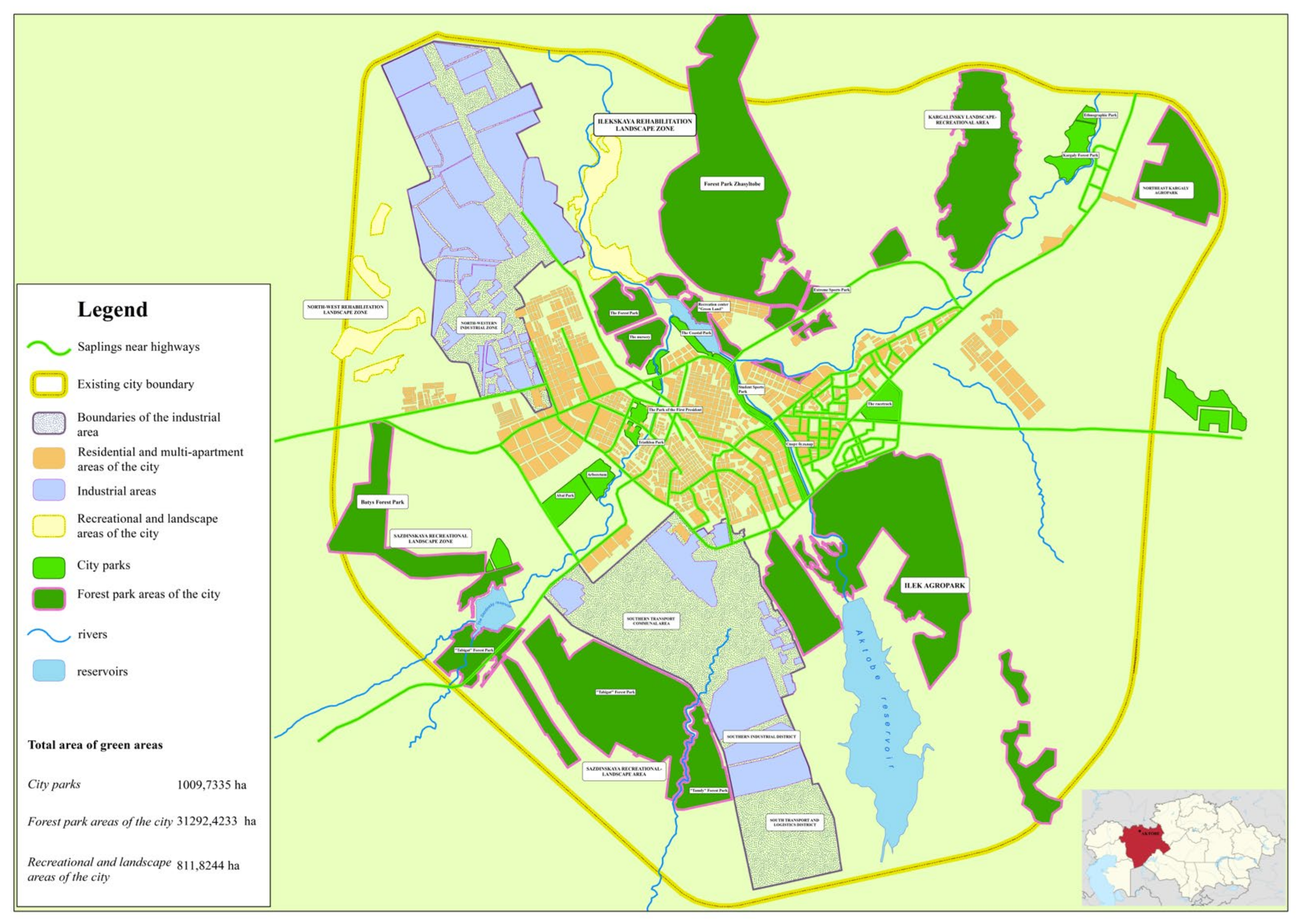
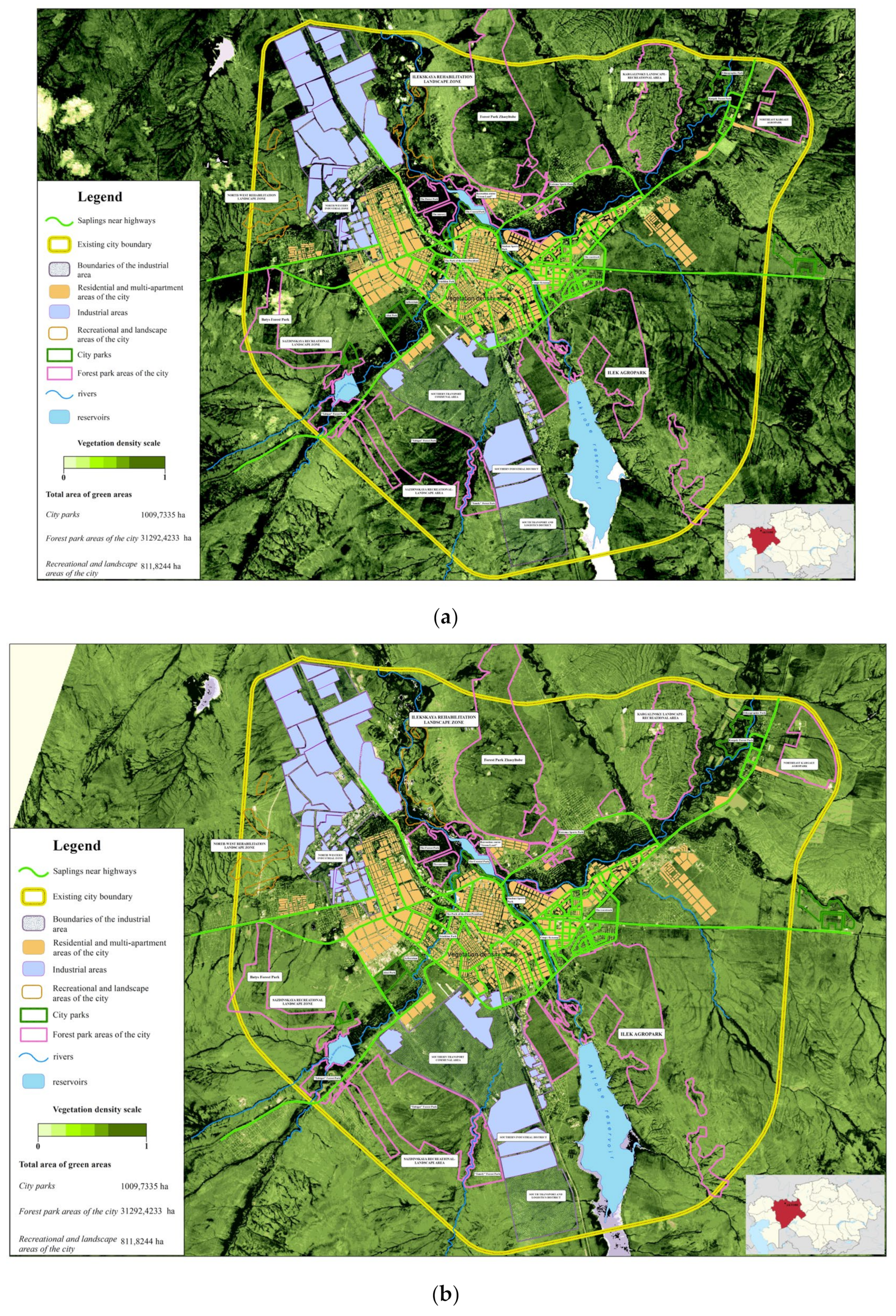
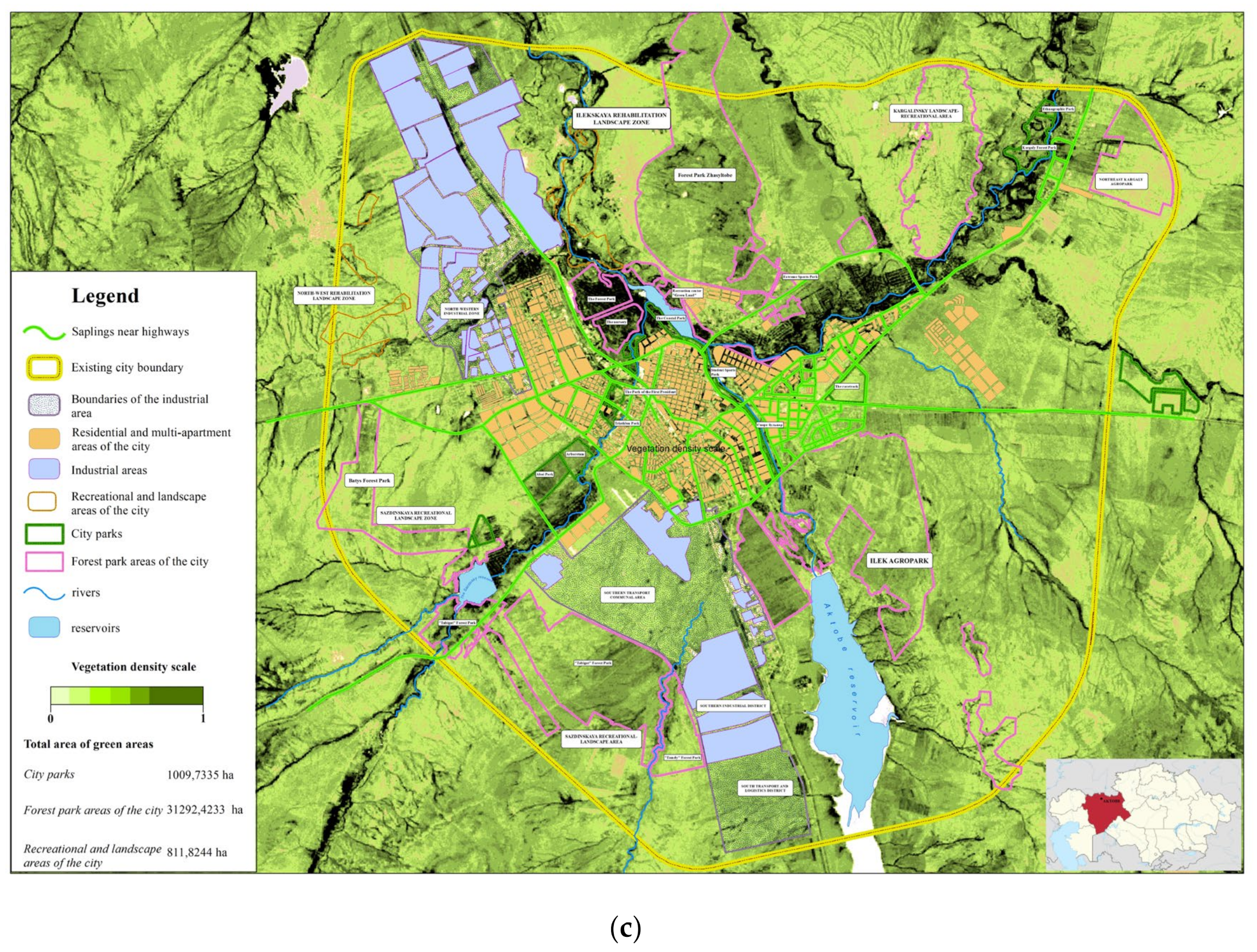
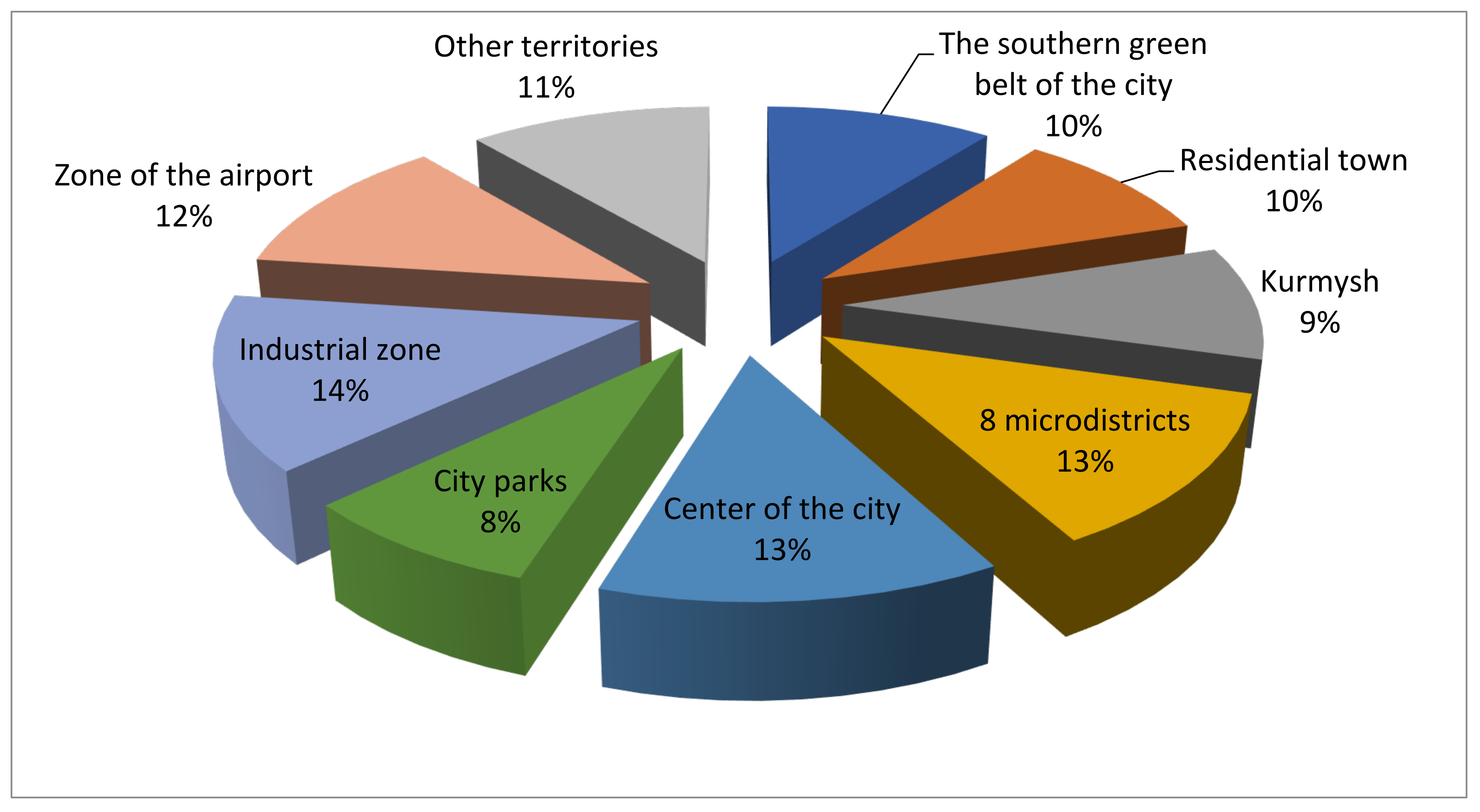
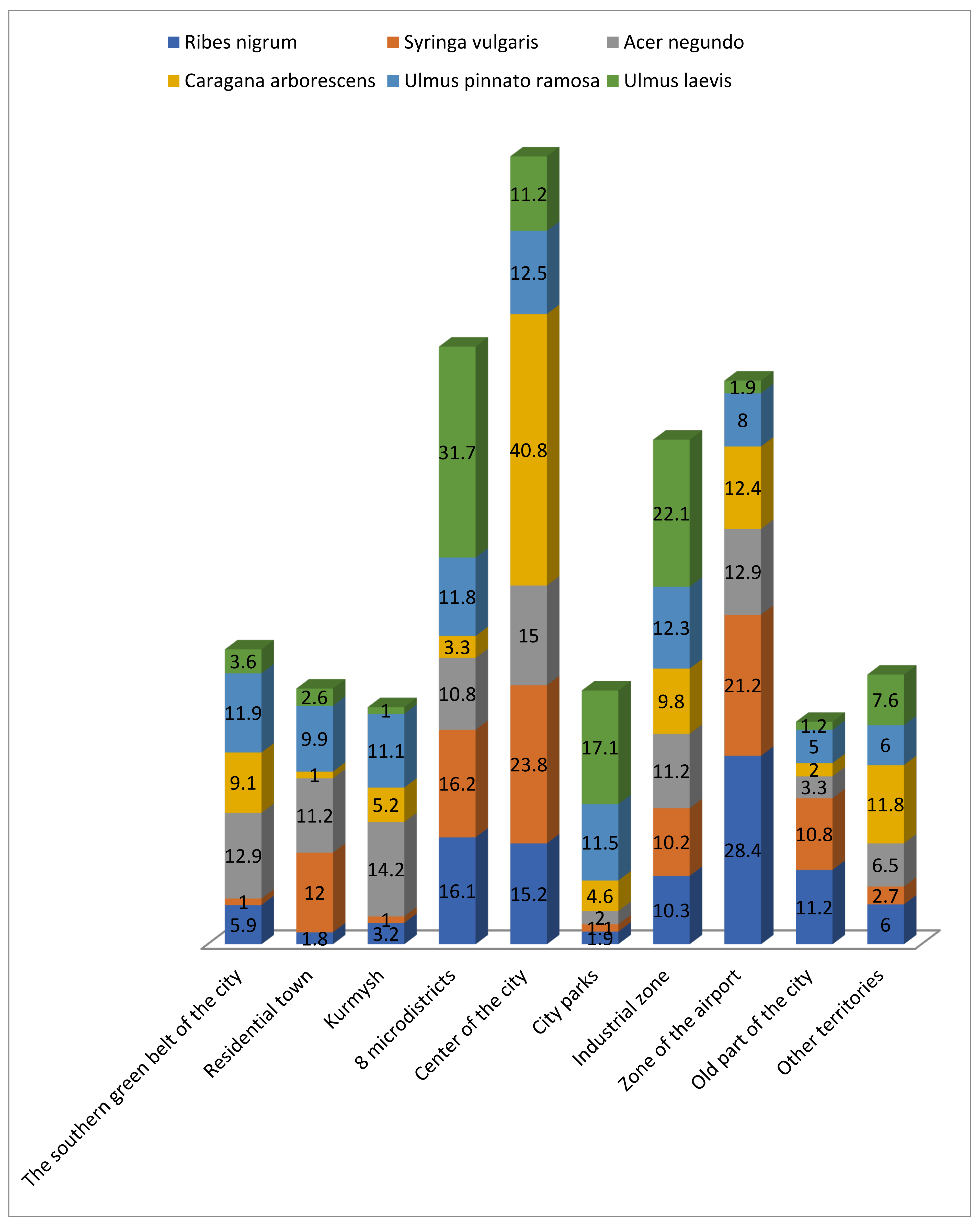

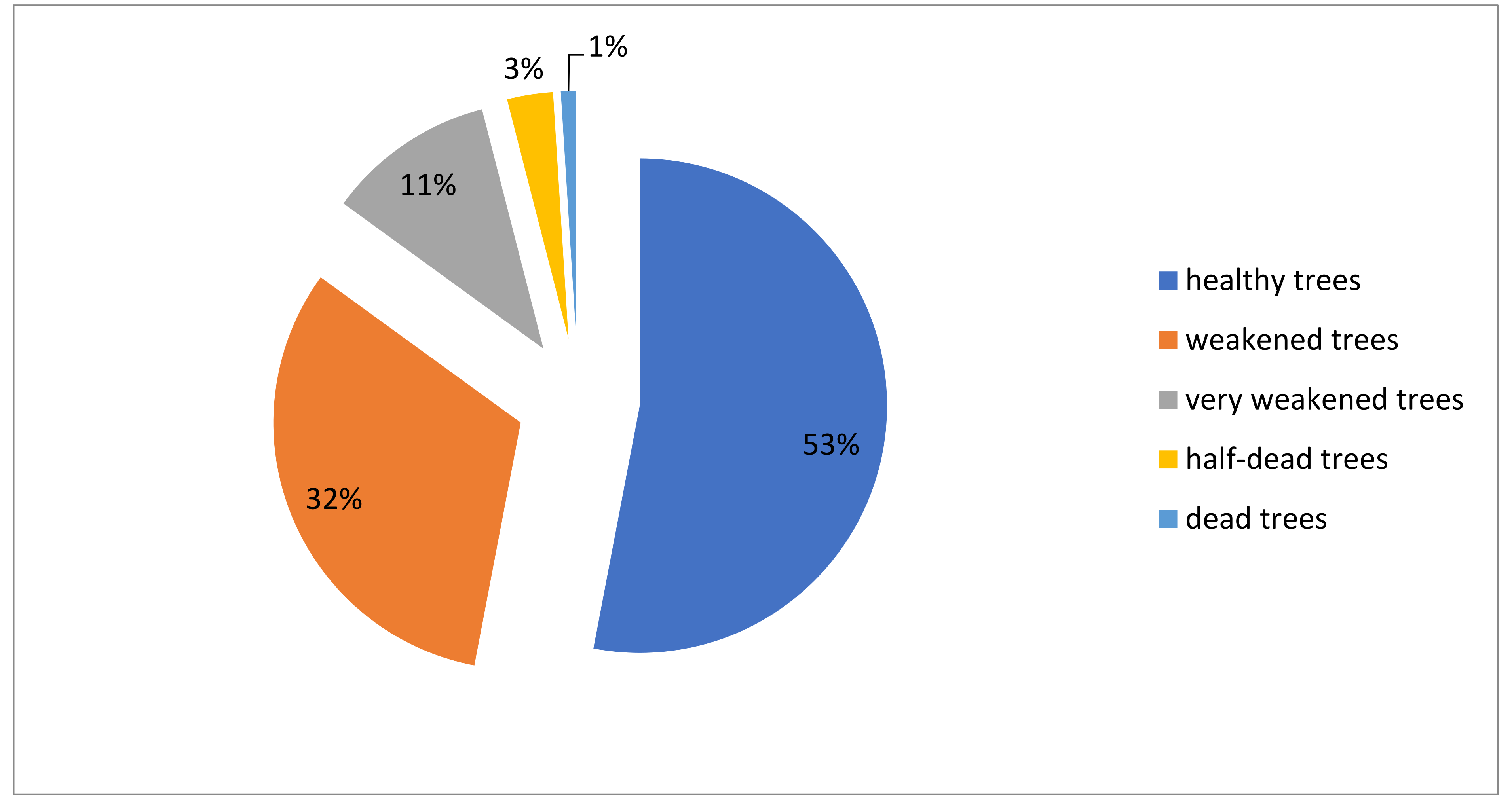
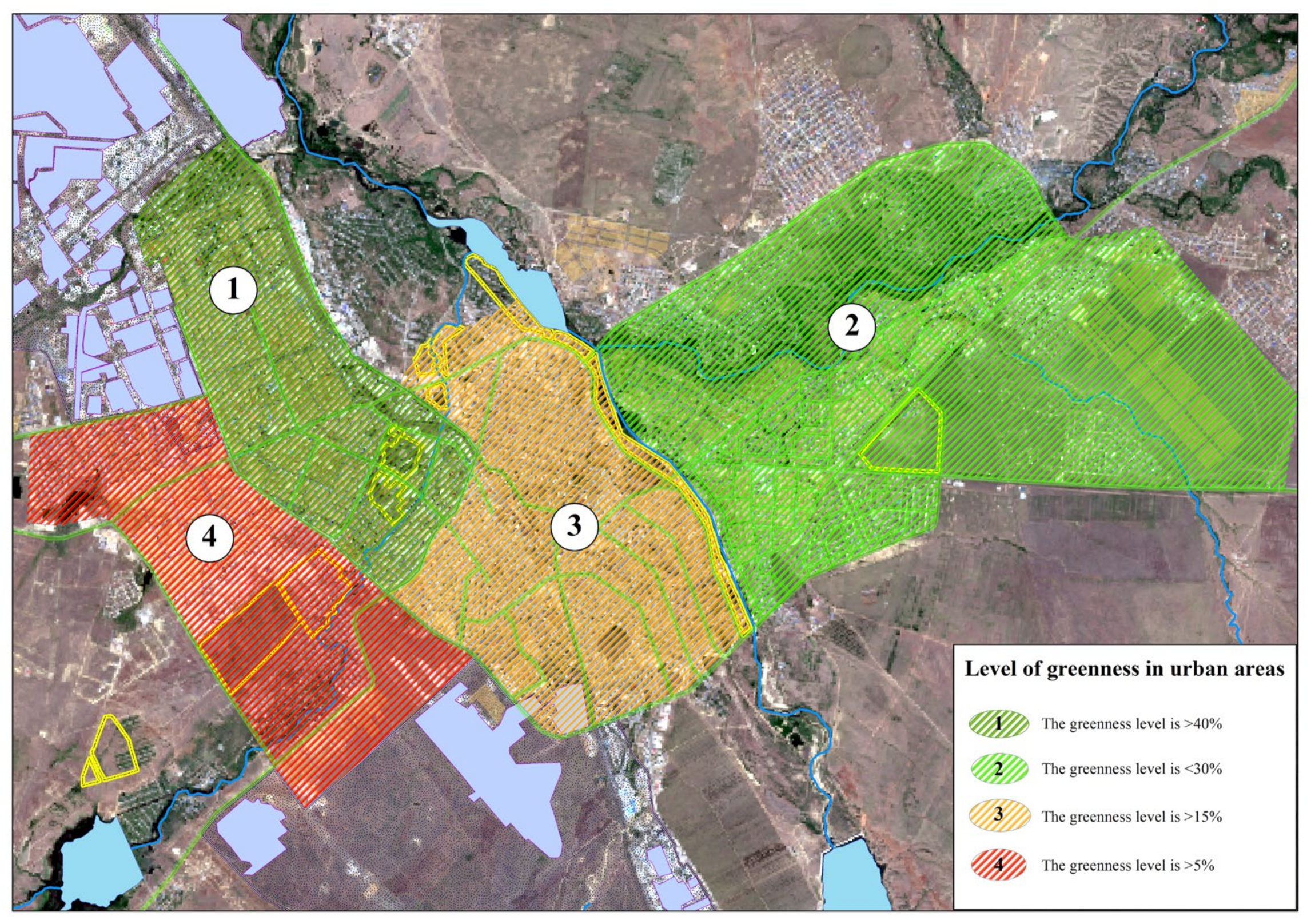
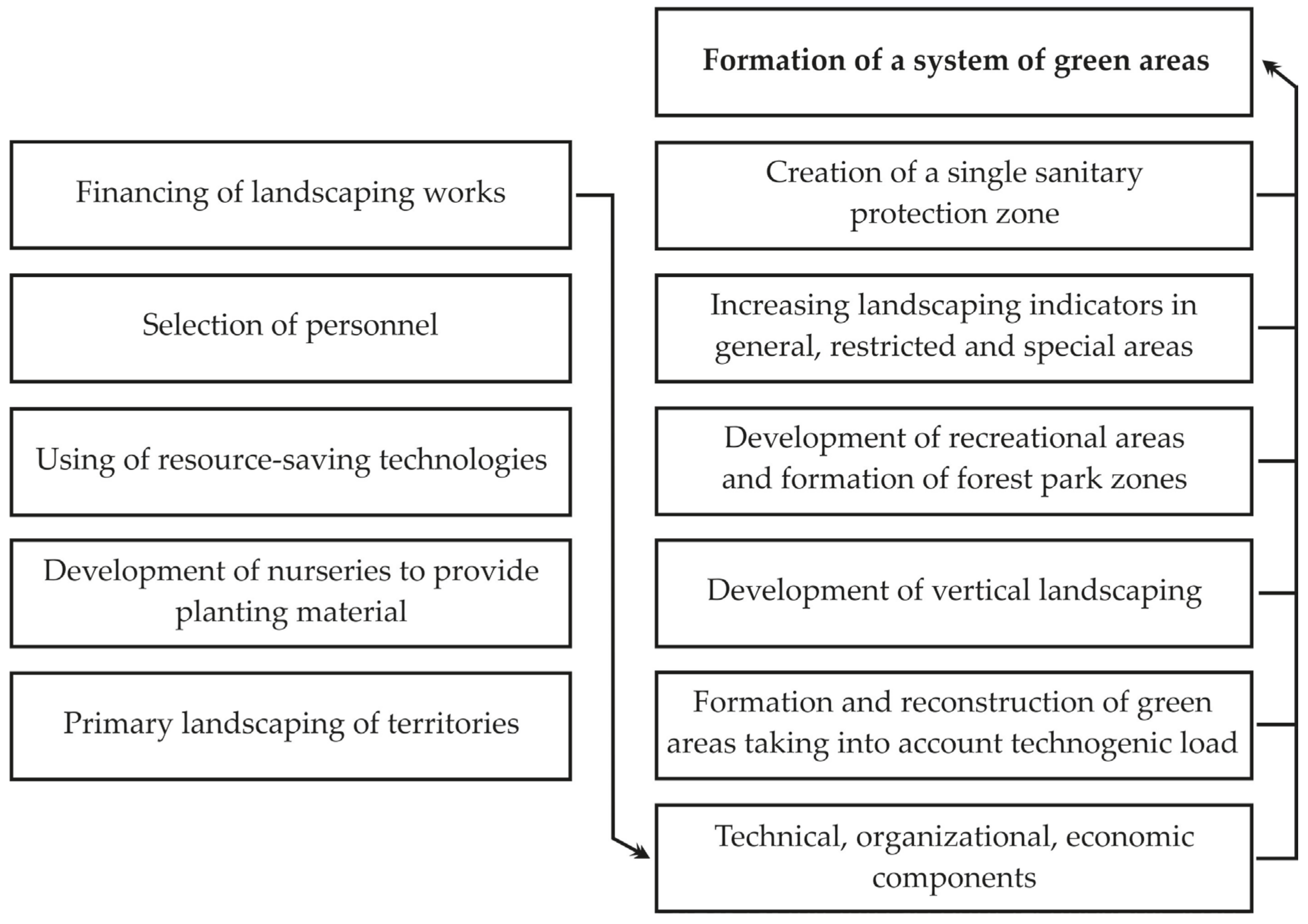
| № | Tree Species | Amount | % of Total Quantity |
|---|---|---|---|
| 1 | Caragana arborescens | 364 | 0.98 |
| 2 | Betula pendula | 503 | 1.35 |
| 3 | Crataegus sanguinea | 527 | 1.42 |
| 4 | Prunus cerasus, Prunus | 408 | 1.09 |
| 5 | Ulmus glabra | 142 | 0.38 |
| 6 | Quercus robur | 29 | 0.08 |
| 7 | Picea pungens | 378 | 1.018 |
| 8 | Picea abies | 117 | 0.31 |
| 9 | Salix | 365 | 0.98 |
| 10 | Sapindaceae | 7 | 0.019 |
| 11 | Catalpa bignonioides | 7 | 0.019 |
| 12 | Ulmus pumila | 18,073 | 48.67 |
| 13 | Acer tataricum | 89 | 0.24 |
| 14 | Acer negundo | 5846 | 15.74 |
| 15 | Elaeagnus angustifolia | 47 | 0.13 |
| 16 | Amelanchier ovalis | 2 | 0.005 |
| 17 | Sorbus aucuparia | 10 | 0.027 |
| 18 | Pinus sylvestris | 387 | 1.04 |
| 19 | Pinus nigra subsp. pallasiana | 35 | 0.09 |
| 20 | Thuja orientalis | 149 | 0.40 |
| 21 | Juniperus communis | 36 | 0.097 |
| 22 | Populus nigra | 206 | 0.55 |
| 23 | Populus alba | 1568 | 4.22 |
| 24 | Populus nigra | 3997 | 10.76 |
| 25 | Prunus padus | 30 | 0.08 |
| 26 | Malus sylvestris | 482 | 1.30 |
| 27 | Fraxinus excelsior | 1691 | 4.55 |
| 28 | Filipendula ulmaria | 201 | 0.54 |
| 29 | Syringa vulgaris | 1240 | 3.34 |
| 30 | Shrubs | 183 | 0.49 |
| 31 | Deciduous trees | 13 | 0.035 |
| Total | 37,132 | 100 | |
| 1 | living hedge, linear m | 4725 | - |
| 2 | Flower gardens and lawns, m2 | 1085 | - |
Disclaimer/Publisher’s Note: The statements, opinions and data contained in all publications are solely those of the individual author(s) and contributor(s) and not of MDPI and/or the editor(s). MDPI and/or the editor(s) disclaim responsibility for any injury to people or property resulting from any ideas, methods, instructions or products referred to in the content. |
© 2024 by the authors. Licensee MDPI, Basel, Switzerland. This article is an open access article distributed under the terms and conditions of the Creative Commons Attribution (CC BY) license (http://creativecommons.org/licenses/by/4.0/).





